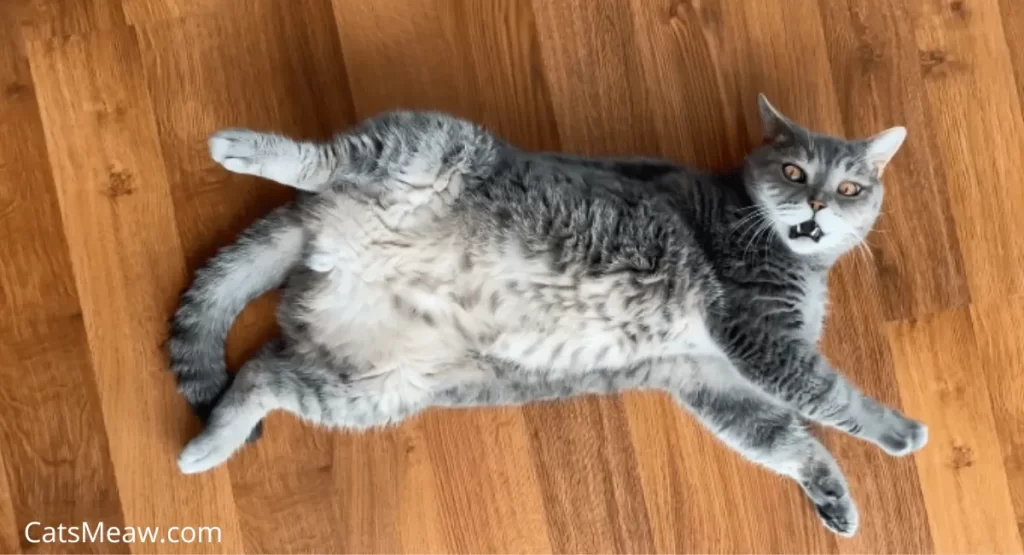Cats are fascinating creatures with unique quirks, and one behavior that often puzzles pet owners is rolling around on the floor. Is it a sign of joy, a call for attention, or something more? In this article, we’ll explore the various reasons Why Do Cats Roll Around? Combining expert insights to give you a comprehensive understanding of why cats roll.

Table of contents
Expression of Comfort and Security
When a cat rolls onto its back, it’s often a sign of trust and relaxation. This vulnerable position shows that your cat feels safe in their environment or around you.
Key Points:
- Trust in Their Surroundings: Rolling and exposing their belly, one of their most sensitive areas, indicates a deep sense of security.
- Not an Invitation to Rub: Despite their relaxed posture, most cats are protective of their bellies. A sudden belly rub may result in defensive swipes or bites. (Learn more about feline body language)
- Relaxed Body Language: A cat lying on its back while stretching or blinking slowly is simply enjoying a moment of calm.
Mating Behavior
For unspayed female cats, rolling is often tied to their reproductive cycle. During heat, this behavior becomes more pronounced.
Key Points:
- Signaling Readiness: Female cats in heat roll as part of their body language to attract males.
- Post-Mating Response: Rolling after mating could be a way for female cats to release tension or spread pheromones.
- What You Should Know: If your female cat displays these behaviors frequently, it might be time to consider spaying for her health and comfort.(Benefits of spaying and neutering cats)
Playfulness and Attention-Seeking
Rolling can also be a playful invitation or a clever way to grab your attention. Cats are masters at ensuring their needs are met, and rolling is a tactic they use effectively.
Key Points:
- Play Invitations: Cats may roll, paw the air, or bat at toys, signaling they’re in a playful mood.
- Attention-Grabbing: Rolling in front of you or in your path is their way of saying, “Notice me!” This is especially common during routines like morning interactions.
- How to Respond: Engage with toys or gentle petting to acknowledge their playful behavior.
Scent-Marking
Cats are territorial animals, and rolling plays a role in marking their space.
Key Points:
- Scent Glands at Work: Cats have scent glands on their cheeks, paws, and flanks. Rolling deposits their scent, helping them mark their territory. (How cats use scent marking)
Related: Best Interactive Toys for Indoor Cats
- Social Context: In multi-pet households, rolling can help cats blend scents with others, fostering harmony.
- Surface Preferences: Cats may roll on carpets, rough floors, or specific areas they want to claim as their own.
Reaction to Catnip
If your cat rolls enthusiastically after sniffing catnip, it’s no coincidence. This behavior is a common response to the herb’s effects.

Key Points:
- Chemical Reaction: Catnip contains nepetalactone, a compound that mimics feline pheromones. This often triggers rolling, face rubbing, and playful energy.
- Short-Lived High: The effects typically last 10–15 minutes before wearing off.
- Not All Cats Respond: About 30% of cats lack the genetic sensitivity to catnip. Alternatives like silver vine can produce similar effects. (Catnip alternatives: Silver vine and valerian root)
Health Concerns
In some cases, rolling behavior might signal discomfort or health issues. It’s important to monitor for signs of distress.
Key Points:
- Skin Irritation or Parasites: Fleas, ticks, or allergies can cause itchiness, prompting cats to roll for relief.
- Abdominal Discomfort: Rolling could indicate digestive issues, urinary tract infections, or other internal discomforts.
- When to See a Vet: If rolling is excessive or accompanied by unusual behaviors like vocalizing or appetite loss, consult a veterinarian.
Stretching Muscles
Cats are natural yogis, and rolling is part of their stretching routine. After a nap, you might catch your cat rolling and stretching to get their blood flowing.
Key Points:
- Post-Nap Routine: Rolling stretches their back, legs, and neck, improving circulation and flexibility.
- Exercise Opportunity: Pair this behavior with toys to encourage physical activity, especially for indoor cats.
Cooling Off or Comforting Sensations
Cats often roll on certain surfaces for comfort or temperature regulation.
Key Points:
- Cooling Off: On hot days, cats may roll on cool surfaces like tile or shaded grass to cool their bodies.
- Enjoying Texture: Rolling on soft carpet or rough concrete may help relieve itchiness or provide sensory stimulation.
Breed-Specific Tendencies
Certain cat breeds are naturally more inclined to roll due to their personality and genetics.
Key Points:
- Laid-Back Breeds: Cats like Scottish Folds, Ragdolls, and Maine Coons are known for their relaxed demeanor and frequent rolling.
- Understanding Breed Traits: Recognizing your cat’s breed characteristics can help you interpret their behavior.
Ritualistic or Habitual Behavior
For many cats, rolling becomes a comforting part of their daily routine.
Key Points:
- Morning Rituals: Cats may roll during greetings, associating this behavior with feeding or petting times.
- Comfort and Predictability: These rituals provide emotional security, reinforcing bonds with their owners.
Conclusion
Cats roll around for various reasons, from showing trust and playfulness to marking territory or signaling discomfort. Understanding the context of this behavior can help you better respond to your cat’s needs. Whether they’re stretching, playing, or cooling off, rolling is a window into your cat’s emotions and well-being. Pay attention to the signals your furry friend sends through this fascinating behavior—it’s one of the many ways they communicate their unique personality to you.
For more insights into feline behavior, don’t hesitate to explore expert resources or consult your veterinarian if something seems off. Your attentive care ensures your cat thrives in both health and happiness.
